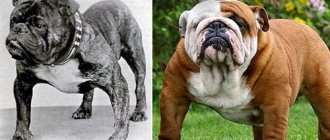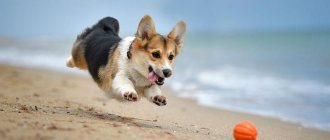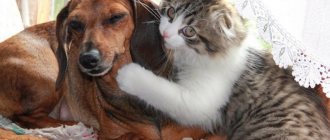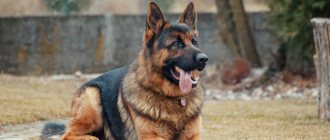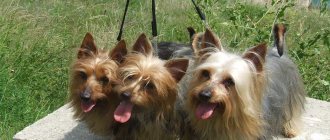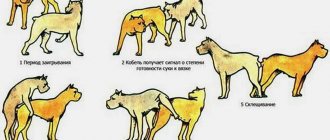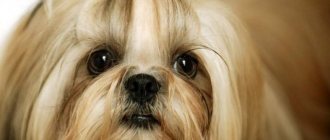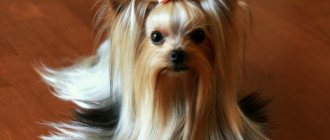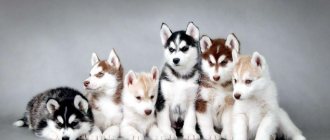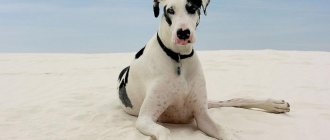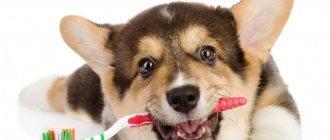| Origin: | Russia |
| Usage: | companion dog |
| Color: | plain |
| Dimensions: | 19-28 cm at the withers |
| Lifespan: | up to 15 years |
Modern breeders are engaged in both breeding well-known breeds and selecting new ones. Russia has recently become the birthplace of a new decorative variety of pets. The Moscow or Russian salon dog, which is also commonly called a mermaid, belongs to the author of Yulia Lakatosh, an experienced livestock specialist and judge of international championships. Miniature dogs are distinguished by their beautiful appearance, open and devoted disposition.
Maintenance and care
Mermaids are very convenient for keeping at home.
They are miniature, clean and neat. They try to spend most of their time next to the owner. Moderately active, content with leisurely walks near the house. The most important point in care is combing. It is necessary so often that caltuns do not form. At the age of 9-12 months, the little mermaid changes her baby fur to an adult one, at which time the fur seems to roll into clumps faster than they can be combed out. Indeed, such a feature exists, but it is a temporary phenomenon. You need to be patient and continue to brush your pet. Adult fur is a little easier to care for. The frequency of scratching varies from dog to dog. For some, once a week is enough, for others, scratching is necessary daily.
Dirty wool rolls into tangles faster, so the little mermaid needs to be bathed regularly, about 1-2 times a month. You should never bathe a dog with tangled fur; after this it will be almost impossible to comb it.
Russian salon dogs require regular grooming. There are three options: general grooming (the dog in its most natural form), “sporty”, “bob”. At shows, dogs with long and short hair are judged equally.
You also need to pay attention to the muzzle. It is advisable to wash your mustache after every meal. Every day it is necessary to wipe the little mermaid's eyes, keeping them clean and healthy. Ears are usually cleaned once every 1-2 weeks. If water gets into them while swimming, you need to dry them thoroughly with a napkin.
To prevent oral diseases, your dog needs to brush its teeth regularly. It is also worth considering that during the change of teeth (at 4-8 months), baby teeth may fall out with a delay. This interferes with the normal growth of molars and in some cases requires the help of a veterinarian.
How to care for a Russian Spaniel
No special care required. Since hunting dogs, especially working dogs, come into contact with wild animals more often than others and are in the forest area, care should be taken to ensure timely vaccination and treatment against external parasites. During the summer, your pet can wear a special anti-flea collar. Regular worming is also necessary.
Despite the great love for bathing, the dog does not need frequent procedures. Spaniels do not have a dog smell, in addition, their fur has a special coating that repels dirt, so washing your pet 3-4 times a year is enough.
Russian spaniels have beautiful, silky hair that should be combed once a week, and any tangles that have formed should be carefully removed. The claws of such active animals wear down on their own; apartment animals rarely need to trim them - once a month.
The dog's long ears require special attention; due to their drooping shape, they are poorly ventilated, and inflammatory processes often occur in them. They need to be examined to identify pathology.
Maintenance and care
Mermaids are very convenient for keeping at home. They are miniature, clean and neat. They try to spend most of their time next to the owner. Moderately active, content with leisurely walks near the house.
The most important point in care is combing. It is necessary so often that caltuns do not form. At the age of 9-12 months, the little mermaid changes her baby fur to an adult one, at which time the fur seems to roll into clumps faster than they can be combed out. Indeed, such a feature exists, but it is a temporary phenomenon. You need to be patient and continue to brush your pet. Adult fur is a little easier to care for. The frequency of scratching varies from dog to dog. For some, once a week is enough, for others, scratching is necessary daily.
Dirty wool rolls into tangles faster, so the little mermaid needs to be bathed regularly, about 1-2 times a month. You should never bathe a dog with tangled fur; after this it will be almost impossible to comb it.
Russian salon dogs require regular grooming. There are three options: general grooming (the dog in its most natural form), “sporty”, “bob”. At shows, dogs with long and short hair are judged equally.
You also need to pay attention to the muzzle. It is advisable to wash your mustache after every meal. Every day it is necessary to wipe the little mermaid's eyes, keeping them clean and healthy. Ears are usually cleaned once every 1-2 weeks. If water gets into them while swimming, you need to dry them thoroughly with a napkin.
To prevent oral diseases, your dog needs to brush its teeth regularly. It is also worth considering that during the change of teeth (at 4-8 months), baby teeth may fall out with a delay. This interferes with the normal growth of molars and in some cases requires the help of a veterinarian.
Nurseries
The birthplace of the breed is Russia, which reduces the difficulty of purchasing a mermaid dog puppy. There are few nurseries that breed them, so the desired puppy will have to be booked long before birth. You can find mermaids in Moscow, the Moscow region and Tula.
The easiest and most reliable way to buy a puppy is to purchase from the author of the breed by contacting the official website https://www.salondog.narod.ru/. The breeder lives and breeds dogs in Moscow.
The Moscow region kennel “York Paradise” − https://yorkparad.umi.ru is breeding the Russian salon breed along with the Yorkshire Terrier and Biewer.
The Tula kennel “Pure Gold” (https://solid-gold.ru) specializes exclusively in mermaid dogs. Additionally, accessories for care and grooming are sold.
The young Russian breed is rare and expensive, but attracts the attention of sophisticated dog breeders. The Russian salon dog is ideally suited for participation in exhibitions and championships. This petite, calm beauty with long, soft fur captivates and attracts the eye. A charming, affectionate dog will respond to its owner with devotion and become a faithful companion, but you will have to spend a lot of time and money caring for it.
Description
Decorative animals do not stand out for their large size; according to approved standards, the dog must grow from 18 to 28 centimeters at the withers. In this case, the pet’s weight will vary between 1.8-3.5 kilograms.
The physique of the Moscow mermaid is slightly elongated, but at the same time dry and compact. The dog is built proportionally. The skull will have a round shape, with a low frontal part, the front part will not be expressive, with a straight back of the nose. Snub nose is not observed; dogs are characterized by some narrowing of the muzzle towards the nose; it will be colored black.
The eyes are of standard size, without convex pupils, and their color is predominantly dark. The ears will be wedge-shaped with pointed ends.
The back of the Russian salon dog is without a bend with the withers, the chest is developed correctly, and has an oval cross-section. There is a slight sloping in the lower back. The tail is located high on the body, sickle-shaped in structure. In a raised position it reaches the back, in the normal state it will be slightly tilted down. It is allowed to be docked, but not more than 1/3 of the total size.
The neck is located high relative to the body, has average length and width parameters, the paws are set parallel, ideally they should be even, but not long, which makes the dog a little squat when viewed. The fingers are gathered into a tight oval-shaped ball. The limbs may be dark in color and spots may be present.
The coat is long, can be straight or wavy, distributed evenly over the body, while a natural parting will form along the body along the lower back. It is very soft to the touch, the undercoat is weakly expressed. There is a natural volume, the structure is a bit like the coat of a Pekingese or Shih Tzu.
LIMBS
LIMBS: The length of the limbs is average. The dog should not look upturned, nor should it be too squat.
FOREQUARTERS: General appearance: When viewed from the front and side, the forelegs are fairly straight and vertical. Placed parallel to each other, not too wide.
Shoulder blades: Shoulder blades sufficiently inclined, not convex or short.
SHOULDERS: Shoulders of medium length, medium slope.
ELBOWS: Elbows point back.
FOREARMS: When viewed from the front, straight forearms are preferred.
WRISTS (CARPAL JOINT): Well formed.
PASTAR: Strong, medium slope. A parallel arrangement relative to each other is desirable.
FEET OF FRONT AND HIND LIMB: Oval, small. The fingers are quite arched. The claws and pads are pigmented in a dark color, matching the color, or flesh-colored if there is white spotting in the color.
HINDQUARTERS: General appearance: Well balanced in structure with the forequarters. When viewed from behind, they are parallel to each other. The angles are moderately pronounced.
HIPS: Hips slightly angled. The hip joints are strong and well formed.
KNEE JOINTS (KNEES): The angles of the knee joints are moderate.
SHIN: Medium length, approximately equal to the length of the thighs.
HICK JOINTS: The hock joints are dry, well defined, and the ligaments are well developed.
HEATERS: Medium length, vertical, parallel when viewed from behind.
History of the breed
The author of the breed is Yulia Lakatosh, a livestock specialist, dog handler and international judge all rolled into one. Living in Moscow, Yulia got the idea to create a dog with which the Russian elite could appear at receptions. Judging by the external features and description, the breed was based on Yorkshire terriers, long-haired red terriers and Pekingese. However, the dog handler keeps the entire chain involved in crossing a secret.
The first purebred offspring of “mermaids” were obtained at the beginning of the 21st century. It turns out that the Russian salon breed is a very young and still small breed. The triumphant public appearance took place in 2013, when the dogs shown won the hearts of thousands of fans. In 2016, a record of copyright documents in the name of Lakatosh appeared in the metrics and documents of the RKF. The breed standard is registered in the FCI in group No. 9.
Eskimo Husky
This unique breed of dog, similar to a wolf, lives next to a person for quite a long period of time, but cannot completely trust him. Therefore, an Eskimo husky should not be kept as a pet dog. At the same time, representatives of these dogs have repeatedly become real rescuers for people, showing conscientiousness in doing their work. They are capable of solving any, even the most difficult, transport problems in the harsh conditions of the Far North.
In modern conditions, it is recommended to keep the Eskimo husky in an enclosure with significant space, in a private country house. Representatives of this breed are characterized by endurance; they are able to calmly endure the lowest northern temperatures and remain reliable hard workers.
Important! Like all sled dogs, the Eskimo husky belongs to the Spitz family, but the habits of representatives of wolves are clearly expressed in it. She practically doesn’t even bark, but only howls protractedly, like a wolf.
The Eskimo husky is a true northern beauty that can amaze everyone with its powerful physique and uncompromising muzzle expression. Due to the harsh conditions of survival, she began to have severity, a fearsome appearance, perseverance, and strong-willed traits. Hard physical labor and hunting became the main areas of use for the Eskimo husky in harsh northern conditions. Representatives of this breed are superior to all other sled dogs in terms of transporting goods; they are capable of transporting very heavy loads over considerable distances.
For all their “wildness,” Eskimo huskies are quite easy to train; they try to listen to their owner, whom they perceive more like a leader because of their herd instinct. These dogs are very independent and independent. You won’t expect any kindness or tenderness from them, but when they are praised, they are satisfied. The Eskimo husky does not flaunt its love and devotion to its owner, but it needs him. She is especially attached to the youngest owners - children. Their main function is to help a person, but without showing sentimental feelings.
Eskimo huskies are quite large, but at the same time they are characterized by a compact and harmonious build. They have powerful limbs, bones, and muscles. Like all sled dogs, their coat is long and thick with an undercoat that is distinguished by its density and the presence of fat, which saves the dogs from severe frosts. The appearance of Eskimo huskies is similar to that of a wolf. The color has no specific standards and is constantly changing. Without sufficient physical activity, modern Eskimo huskies have become prone to many diseases.
These animals do not require special care; you need, as usual, to keep their fur clean, comb it, feed it properly and in a balanced manner, provide it with vitamins, walk it, providing freedom and the opportunity for sufficient physical activity. Eskimo Huskies are trainable, but they also love to play while being trained. These are excellent guards. They do not expect systematic praise from the owner, sometimes their behavior is characterized by arrogance, but they become attached to the owner in their own way.
Sled dogs are special animals. They are all hardy, reliable, and hardworking. But if you want to have such an animal, then you need to think carefully about all the pros and cons. After all, representatives of such breeds sometimes combine incompatible things and require a lot of effort from the owner and family members. Therefore, the owners of such dogs must also be, in some way, workaholics in order to better understand the needs of their pets.
Education and training
The intelligence of mermaids can be described as average. These dogs are trainable and successfully master from 5 to 10 commands, which can be constantly used in everyday life or simple stage performances (for example, in dancing with dogs).
Dogs of this breed are attentive, interested in work and are tuned to contact with the owner, but they have a fairly sensitive psyche, so when working with them you should use fairly gentle methods, this will allow you to achieve the best results. Mermaids are sensitive to the tone and intonation of their voices. You should exercise frequently, regularly, but without long continuous exercises, so as not to overload the dog.
It must be said that working with a mermaid is not only possible, but also necessary, since training, teaching the dog new skills is an important element of socialization for the dog and building contact with the owner, and for the owner it makes interaction with his dog simpler and more comfortable.
Main types of colors
Beaver
It has a bright, white-black-red color and a black nose, while the proportional ratio of colors can be any: along with beavers, which have a white color with small spots, there are also individuals whose main color could be called, rather, black.
However, it is the light-colored dogs that are most popular.
Biro
It is colored white-brown-red, the location of the spots and their size may vary.
There are also almost brown biros that have a slight tan and small white markings (shown in the photo).
The nose of Biro Yorkies is brown in various shades.
The main color of the coat is golden-fawn of various tones.
May be supplemented with small white markings.
Chocolate or choco
Its color can be any of the brown tones: from light brownish to dark chocolate.
There may be some small white markings and tan, but its color is not the deep red of the Biro, but rather a pale brown.
Black
The color of his coat should be intense black.
Small white markings are acceptable, such as a white “tie” or “socks”, as well as a narrow blaze on the forehead.
White
Such dogs are very rare (shown in the photo).
Ideally they should be snow white.
The eyelids, nose and edges of the lips are only allowed to be black, and the eyes should be as dark a brown shade as possible.
Appearance and standards
The Russian Salon is a small decorative dog with a strong, dry build, slightly elongated, proportionally built. Thanks to the abundant fur, it looks very elegant. The height of dogs is from 18 to 28 cm: weight – 1.8-3.5 kg
The head is proportional to the body. The skull is rounded. The forehead is quite high. The stop is deep and well expressed. The muzzle is of medium width and depth, neither long nor short, tapering slightly towards the nose. The bridge of the nose is without folds, straight, located approximately at the level with the lower eyelids. The eyes are medium in size, oval in shape, dark in color, not too protruding, set straight, quite wide. The ears are medium in size, set high, erect, triangular, with pointed tips. The nose is dark in color, shiny, slight lightening is allowed.
Compact build. The length of the body is slightly greater than the height. The topline is straight. The chest is well developed, oval in cross-section. The abdomen is moderately tucked. The tail is set high and crescent-shaped.
The natural coat should be as long and straight as possible. Evenly distributed throughout the body. There is a parting along the spine. The wool is soft to the touch and has medium volume. There is little undercoat. Mermaids differ from Yorkies in their hair structure. In terriers it is silky, but in the Russian salon it is more voluminous, to the touch it is something between the hair of a Shih Tzu and the downy Chinese Crested. The color is solid in any red range from red, rich, to fawn or cream. A clean, rich color is most desirable. There may be a dark mask on the face.
Characteristic
So, as you probably already guessed, “mermaids” are most reminiscent of show-class pets, whose main purpose is to simply be next to a person as a companion. As for appearance, for their small size they are quite massive animals, with medium bones and square shapes.
The muzzle is not very long, the bite is scissor-shaped or pincer-shaped, although options for a tight bite or “reverse scissors” are also allowed. The bangs should not fall into the eyes, so they are always tied or pinned on the head.
The body of “mermaids” is described in one word - “compact”, with a high-set tail and long hair that flows smoothly downwards. It is divided into a parting along the back.
Important! The coat of the breed grows very quickly, therefore, in order to prevent the pet from becoming tangled and untidy, the coat should be trimmed and combed regularly.
Typically, among Russian salon dogs there are more red representatives, with colors ranging from light tones (the so-called “white gold”) to deep red and even red. In some cases, the ends of the hairs are painted black, causing the color to become “sable” or “murugi.” You can often find “little mermaids” with a dark mask on their faces, which is also allowed by the standard.
Spotty salon dogs are slightly less common, on which white markings are clearly visible on the already familiar red background. In rare cases, the white markings spread over almost the entire body, leaving the red color only in certain places.
Choosing a puppy and prices
Considering that Russian “little mermaids” are a young breed, it is difficult to buy a puppy today. A limited number of nurseries are engaged in breeding the breed. All litters undergo mandatory registration with the Canine Association. In addition, when completing the documents, an author's certificate for the breed with the signature of Yulia Lakatosh is also attached. The assigned individual numbers are registered in the stud books.
Obviously, the proposal to sell Russian salon puppies via the Internet is questionable. If you decide to purchase a pet via the Internet, ask the owner of the advertisement to scan all documents for parents and offspring. The starting price for mermaid puppies is 20 thousand rubles. The cost consists of several factors: gender, age, color, breed purity. Due to these requirements, the price of puppies from the same litter can vary significantly.
When purchasing a decorative dog, a person must understand that he is not buying a toy, but a full-fledged animal with its own character. It often happens that a baby is presented as a gift to female representatives who are not ready for the presence of even such a small dog in the house. The other extreme is to “squeeze” the pet. Respect your little friend and you will have a wonderful relationship.
Origin story
Presumably, the Nenets Laika descended from the turf dog, which lived more than 5,000 years ago over a vast territory from Western Europe to Siberia, and was bred for centuries in almost complete isolation, therefore it is considered the oldest and purebred. This dog was to the taste and usefulness of the ancient hunter, then the nomad, and the reindeer herder. She adapted to people and their requirements without changing much.
The Nenets Laika is distinguished by natural harmony and great functionality of the exterior. Its “northern appearance” immediately catches the eye.
The breed belongs to the Arctic Spitz group, which also includes the Finnish and Swedish Lapinkoira and the Icelandic Sheepdog. Nenets reindeer herders have always been loved and popular among the Nenets, used by other peoples in Kamchatka and Chukotka, but outside the reindeer herding regions they were practically unknown.
At the end of the 19th - beginning of the 20th centuries, white Nenets huskies were exported from Western Siberia to Western Europe, which gave rise to the now popular breed of Samoyed dog (Samoyed).
The Nenets Laika was first shown to the general public at the anniversary exhibition of the Imperial Society for Proper Hunting in 1898. In the 40s of the twentieth century, she regularly appeared at the All-Union Agricultural Exhibition. The first standard was written in the 50s. After its publication, the Nenets Laika began to be bred using factory methods. A large nursery appeared in Petropavlovsk-Kamchatsky, where Nenets huskies were imported from Koryakia and Chukotka. Later the dogs were taken to St. Petersburg and Moscow.
The Nenets Laika is not a sled dog. To the point that the Nenets considered it a bad omen to harness her to a sleigh.
Modernity has affected the Nenets Laika in two ways. On the one hand, their number has greatly decreased. At one time it was almost impossible to get a purebred dog, even from reindeer herders. On the other hand, cynological interest arose in the breed, including in foreign dog breeding; it was prompted by the flow of information about reindeer racers, their uniqueness, amazing abilities and talents.
Traditional use of Nenets Laikas
- Shepherd's service. Nenets Reindeer Dogs move at significantly higher speeds than herding dogs that work with sheep or cattle. They drive stray deer to the herd, do not allow them to disperse into groups, and help the shepherd look for lost and stray animals. On command, the reindeer are wrapped up or the group he points to is brought to the owner. The reindeer husky never runs into the center of the herd; it only works along the edge. She is very playful and barks occasionally.
- Hunting with Nenets Spitz is very limited. Often, hunting behavior was purposefully interfered with by shepherds. Other peoples, unlike the Nenets, often used Nenets Laikas to hunt small and large animals. Dogs are capable of tracking, stopping game and detecting wounded animals.
- The sanitary function consists of dogs eating almost all leftover food and waste after cutting fish, deer, and other animals caught during the hunt. On the territory of the camp they destroyed rodents.
- Guard service. Nenets Laikas are vigilant watchmen who will always warn of the appearance of strangers and dogs near the herd or plague. Very rarely, particularly aggressive individuals were encountered among the Nenets Spitz; they were not attracted to herding, but were used for protection.
The Nenets Laika is actually very multifunctional. Its name “reindeer herding” often misleads people unfamiliar with the breed and does not contribute in any way to its popularization and dissemination.
- Accompanying a person. Being a devoted companion and assistant is another important function of the Nenets Laika. You can find many stories of how these dogs saved their owner by leading a wild animal away, or helped them find their way in a snowstorm.
- Several dogs are used by the Ministry of Emergency Situations in rescue and search operations;
- Hybrids of the jackal and the Nenets Laika (Sulimov's dogs) work in the security service of Sheremetyevo (Moscow).
Appearance
The mermaid is a miniature dog, average weight from 1.8 kg to 3.5 kg, height at the withers about 20 cm, but there are individuals with a range from 18 to 28 cm.
Compact, proportional build, slightly elongated body. The head is rounded, the muzzle is medium in size with a high frontal part and a straight back of the nose, black in color. The eyes are oval in shape and always dark in color.
The body is dense, with a straight back, pronounced withers and a well-developed chest.
The tail is crescent-shaped, set high, and can be docked by 1/3.
The limbs are straight and not very long, which creates the feeling of a slightly squat silhouette.
The main feature of this breed is the variety of possible colors.
FLAWS
Round, excessively bulging or too close-set eyes, insufficiently hard ear cartilage, overbite, curved or very shortened forearms, excessive long legs, sloping croup, excessive or insufficient body weight.
Defects leading to disqualification: Cryptorchidism, aggressive or hysterical behavior, lack of hair on the face, hard, coarse hair, low, hanging ears, non-standard colors.
NB: Males must have two normal testes fully descended into the scrotum.
*A comment
Hair cutting and grooming are allowed, haircut includes the following options:
1. General grooming - the contour of the head and body is trimmed, the paw pads and base of the tail are trimmed, the “skirt” is slightly straightened so as not to interfere with freedom of movement while maintaining the maximum possible length of the coat. The ears are trimmed short in the upper third. The bangs are secured with a bow.
2. Haircut – “Bob”. The hair on the body is shortened at or slightly below chest level. The bangs are secured with a bow on the head, and the beard and mustache are trimmed along a straight horizontal line at neck level. The limbs, throat, neck and tail are also trimmed a little.
3. Haircut – “Sports”. The body, neck, hips and shoulders are cut short. The bangs are secured with a bow on the head, the silhouette of the head is formed in the form of a ball or “bob”. The limbs are formed in the form of “columns”, the fingers can be cut short. Smooth transitions are made from short hair on the body to long hair on the limbs. The fur on the tail is formed in the form of a “feather”.
Character, habits and temperament
There is information that the breeders who created the new breed still pay a lot of attention to the character traits of the Russian salon dog.
Of course, all animals must fully meet the requirements for the breed group, which are also typical for other ornamental pets.
Did you know? Dogs can smell a specific smell that is released when insulin levels in the human body drop. With proper training, four-legged friends can even tell their diabetic owner when they need to take medication.
Such animals should always remain kind and friendly, show activity and playfulness, while maintaining loyalty to the owner.
In principle, “mermaids” are already endowed with all these qualities, and they build relationships well not only with humans, but also with other pets. Perfect for families with no very small children.
In addition, representatives of the breed are positioned as very obedient, intelligent and flexible dogs that do not show any aggression. They are very balanced and not shy.
Application
The mermaid decorative salon dog was bred to be a devoted companion and does its job well. She sensitively senses the mood of the owner, and also knows how to adapt to him.
If the owner is resting, the pet will happily sit next to him and enjoy being scratched. And if the owner goes for a walk, the mermaid will faithfully follow him.
This breed of dog is best suited for families where there are no children or where they are old enough not to disturb the dog.
Its fragile build and small size require careful handling, which is not always possible to obtain from a small child.
A mermaid will brighten up the lives of lonely or elderly people who enjoy a measured lifestyle.
The Moscow salon dog is completely devoid of abilities for service or security activities, has no inclinations for sports achievements, and is not interested in hunting.
Dogs that didn't get recognition
Many breeds of sled dogs today have already become widely known among dog lovers, but are still not officially recognized by the same International Federation of Cynologists. The reasons for this can be different - sometimes experts do not see a fundamental difference from existing breeds or consider the new product to be a banal cross between two purebred parents of different sled dogs, or the reason lies in simple bureaucratic red tape and the dog is about to be recognized. These most often include the following common animals:
Alaskan Husky - extremely popular in the USA, breaks speed records in harness, but the procrastination, apparently, is of natural origin - no one bred such a dog on purpose, and there is no standard for it either;
Sakhalin Husky, or Gilyak Laika - despite the fact that it is named after the now Russian island of Sakhalin, it is bred mainly in Japan, suitable for both harness and hunting;
Chinook - does not look like a husky at all, which does not prevent this large dog from rushing with agility almost at the level of a husky, it is also a good option for protecting people and territory;
Norwegian Greyster is a special breed that was bred recently, never used by any people of the North, but created specifically for competitions;
wolfdog - a Russian invention, which is a cross between a German shepherd and a wild wolf, is distinguished by specific semi-wild behavior and is still not officially sold anywhere;
Eskimo and Yakut Laika are rare examples of how a sled dog can be suitable for both guarding and hunting.
Differences from York
Despite the external similarity in the photo, the Yorkshire terrier and the Russian salon dog have many differences:
- The history of the formation of the Yorkshire breed is almost 30 years older.
- Mermaids have short limbs, while terriers have longer ones.
- The coat color of the Moscow salon dog includes all shades of red, and the color of Yorkies is gray-steel with reddish markings.
- Terriers do not have facial masks; mermaids are allowed to wear them.
- Russian salon dogs, unlike Yorkies, have a soft, fluffy, much more voluminous hair structure.
- Yorkshire terriers have no undercoat at all, while mermaids have it, although it is not thick.
Puppies of the showroom decorative breed do not change colors with age, as Yorkies do.
Health
The Russian salon breed was crossed to produce dogs that would lose the genetic predispositions to diseases of the parent species.
Mermaids have good health and a long lifespan, but not enough generations have gone through selection to accurately determine the possible risks. The main achievement is the absence of a tendency to allergies and good immunity.
An annual veterinary examination, following the doctor’s recommendations, as well as compliance with preventive measures significantly increases the dog’s chance of staying healthy.
